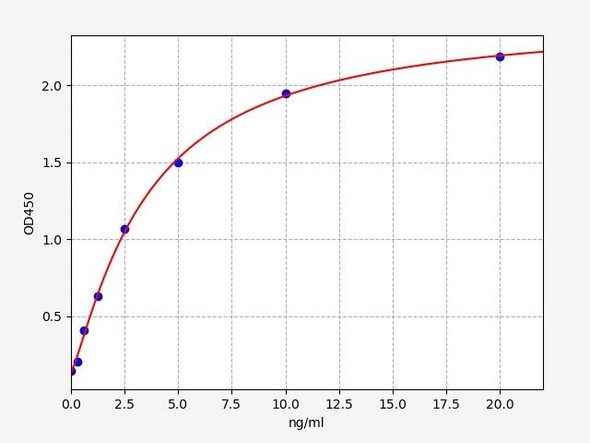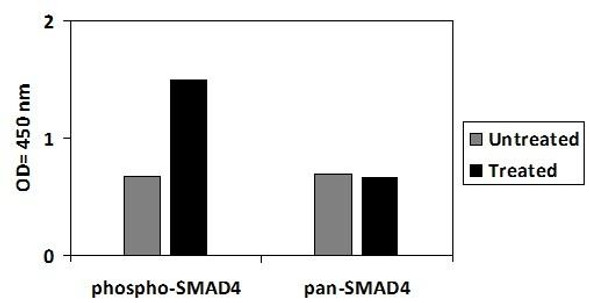Rat Smad4/MADH4 ELISA Kit (RTFI01134)
- SKU:
- RTFI01134
- Product Type:
- ELISA Kit
- Size:
- 96 Assays
- Uniprot:
- O70437
- Sensitivity:
- 18.75pg/ml
- Range:
- 31.25-2000pg/ml
- ELISA Type:
- Sandwich
- Synonyms:
- Smad4, MADH4, MAD homolog 4, Mothers against DPP homolog 4, Deletion target in pancreatic carcinoma 4, SMAD family member 4, SMAD 4, Smad4, Hsmad4
- Reactivity:
- Rat
- Research Area:
- Epigenetics and Nuclear Signaling
Description
Rat Smad4/MADH4 ELISA Kit
The Rat SMAD4/MADH4 ELISA Kit is a highly sensitive and reliable assay designed for the accurate detection of SMAD4 levels in rat serum, plasma, and cell culture supernatants. This kit is ideal for researchers studying the function of SMAD4 in various biological processes, including cell growth, differentiation, and apoptosis.SMAD4, also known as MADH4, is a critical protein in the TGF-β signaling pathway, regulating gene expression and cellular responses to growth factors.
Dysregulation of SMAD4 has been linked to numerous diseases, including cancer, fibrosis, and autoimmune disorders, making it a key target for therapeutic development.With its innovative design and proven performance, the Rat SMAD4/MADH4 ELISA Kit provides researchers with a powerful tool for investigating the role of SMAD4 in health and disease. Trust Assay Genie for accurate and reproducible results in your research studies.
| Product Name: | Rat Smad4/MADH4 ELISA Kit |
| Product Code: | RTFI01134 |
| Size: | 96 Assays |
| Target: | Rat Smad4 |
| Alias: | Smad4, MADH4, MAD homolog 4, Mothers against DPP homolog 4, Deletion target in pancreatic carcinoma 4, SMAD family member 4, SMAD 4, Smad4, Hsmad4 |
| Reactivity: | Rat |
| Detection Method: | Sandwich ELISA, Double Antibody |
| Sensitivity: | 18.75pg/ml |
| Range: | 31.25-2000pg/ml |
| Storage: | 4°C for 6 months |
| Note: | For Research Use Only |
| Recovery: | Matrices listed below were spiked with certain level of Rat Smad4 and the recovery rates were calculated by comparing the measured value to the expected amount of Rat Smad4 in samples. | ||||||||||||||||
| |||||||||||||||||
| Linearity: | The linearity of the kit was assayed by testing samples spiked with appropriate concentration of Rat Smad4 and their serial dilutions. The results were demonstrated by the percentage of calculated concentration to the expected. | ||||||||||||||||
| |||||||||||||||||
| Intra-Assay: | CV <8% | ||||||||||||||||
| Inter-Assay: | CV <10% |
| Uniprot: | O70437 |
| UniProt Protein Function: | SMAD4: transcription factor that mediates signal transduction by the transforming growth factor superfamily. The common smad (co-smad). Binds directly to consensus DNA-binding elements in the promoters of target genes. Promotes binding of the Smad2/Smad4/Fast-1 complex to DNA and provides an activation function required for Smad1 or Smad2 to stimulate transcription. |
| UniProt Protein Details: | Protein type:Nuclear receptor co-regulator; Transcription, coactivator/corepressor; DNA-binding Chromosomal Location of Human Ortholog: 18q21.1 Cellular Component: nucleoplasm; centrosome; transcription factor complex; cytoplasm; nuclear chromatin; nucleus; cytosol Molecular Function:collagen binding; identical protein binding; protein binding; protein homodimerization activity; transforming growth factor beta receptor, common-partner cytoplasmic mediator activity; DNA binding; sequence-specific DNA binding; metal ion binding; chromatin binding; transcription factor activity Biological Process: developmental growth; axon guidance; somatic stem cell maintenance; positive regulation of transcription, DNA-dependent; sebaceous gland development; negative regulation of transcription from RNA polymerase II promoter; palate development; BMP signaling pathway; negative regulation of cell proliferation; regulation of transforming growth factor beta receptor signaling pathway; transforming growth factor beta receptor signaling pathway; mesoderm development; neural crest cell differentiation; positive regulation of BMP signaling pathway; transcription initiation from RNA polymerase II promoter; regulation of transforming growth factor-beta2 production; transcription, DNA-dependent; regulation of binding; in utero embryonic development; neuron fate commitment; positive regulation of transforming growth factor beta receptor signaling pathway; gastrulation with mouth forming second; somite rostral/caudal axis specification; formation of anatomical boundary; SMAD protein complex assembly; endothelial cell activation; cell proliferation; ureteric bud branching; response to hypoxia; positive regulation of transcription from RNA polymerase II promoter; gene expression; regulation of hair follicle development; negative regulation of cell growth; negative regulation of transcription, DNA-dependent; negative regulation of protein catabolic process; endoderm development Disease: Pancreatic Cancer; Juvenile Polyposis Syndrome; Myhre Syndrome; Juvenile Polyposis/hereditary Hemorrhagic Telangiectasia Syndrome |
| NCBI Summary: | This gene encodes a member of the Smad family of signal transduction proteins. Smad proteins are phosphorylated and activated by transmembrane serine-threonine receptor kinases in response to transforming growth factor (TGF)-beta signaling. The product of this gene forms homomeric complexes and heteromeric complexes with other activated Smad proteins, which then accumulate in the nucleus and regulate the transcription of target genes. This protein binds to DNA and recognizes an 8-bp palindromic sequence (GTCTAGAC) called the Smad-binding element (SBE). The protein acts as a tumor suppressor and inhibits epithelial cell proliferation. It may also have an inhibitory effect on tumors by reducing angiogenesis and increasng blood vessel hyperpermeability. The encoded protein is a crucial component of the bone morphogenetic protein signaling pathway. The Smad proteins are subject to complex regulation by post-translational modifications. Mutations or deletions in this gene have been shown to result in pancreatic cancer, juvenile polyposis syndrome, and hereditary hemorrhagic telangiectasia syndrome. [provided by RefSeq, Aug 2017] |
| UniProt Code: | O70437 |
| NCBI GenInfo Identifier: | 4885457 |
| NCBI Gene ID: | 4089 |
| NCBI Accession: | NP_005350.1 |
| UniProt Secondary Accession: | O70437,P97471, O70437, |
| UniProt Related Accession: | Q13485 |
| Molecular Weight: | |
| NCBI Full Name: | mothers against decapentaplegic homolog 4 |
| NCBI Synonym Full Names: | SMAD family member 4 |
| NCBI Official Symbol: | SMAD4 |
| NCBI Official Synonym Symbols: | JIP; DPC4; MADH4; MYHRS |
| NCBI Protein Information: | mothers against decapentaplegic homolog 4 |
| UniProt Protein Name: | Mothers against decapentaplegic homolog 4 |
| UniProt Synonym Protein Names: | Deletion target in pancreatic carcinoma 4; SMAD family member 4 |
| Protein Family: | Mothers against decapentaplegic |
| UniProt Gene Name: | SMAD4 |
| UniProt Entry Name: | SMAD4_HUMAN |
| Step | Procedure |
| 1. | Set standard, test sample and control (zero) wells on the pre-coated plate respectively, and then, record their positions. It is recommended to measure each standard and sample in duplicate. Wash plate 2 times before adding standard, sample and control (zero) wells! |
| 2. | Aliquot 0.1ml standard solutions into the standard wells. |
| 3. | Add 0.1 ml of Sample / Standard dilution buffer into the control (zero) well. |
| 4. | Add 0.1 ml of properly diluted sample ( Human serum, plasma, tissue homogenates and other biological fluids.) into test sample wells. |
| 5. | Seal the plate with a cover and incubate at 37°C for 90 min. |
| 6. | Remove the cover and discard the plate content, clap the plate on the absorbent filter papers or other absorbent material. Do NOT let the wells completely dry at any time. Wash plate X2. |
| 7. | Add 0.1 ml of Biotin- detection antibody working solution into the above wells (standard, test sample & zero wells). Add the solution at the bottom of each well without touching the side wall. |
| 8. | Seal the plate with a cover and incubate at 37°C for 60 min. |
| 9. | Remove the cover, and wash plate 3 times with Wash buffer. Let wash buffer rest in wells for 1 min between each wash. |
| 10. | Add 0.1 ml of SABC working solution into each well, cover the plate and incubate at 37°C for 30 min. |
| 11. | Remove the cover and wash plate 5 times with Wash buffer, and each time let the wash buffer stay in the wells for 1-2 min. |
| 12. | Add 90 µL of TMB substrate into each well, cover the plate and incubate at 37°C in dark within 10-20 min. (Note: This incubation time is for reference use only, the optimal time should be determined by end user.) And the shades of blue can be seen in the first 3-4 wells (with most concentrated standard solutions), the other wells show no obvious color. |
| 13. | Add 50 µL of Stop solution into each well and mix thoroughly. The color changes into yellow immediately. |
| 14. | Read the O.D. absorbance at 450 nm in a microplate reader immediately after adding the stop solution. |
When carrying out an ELISA assay it is important to prepare your samples in order to achieve the best possible results. Below we have a list of procedures for the preparation of samples for different sample types.
| Sample Type | Protocol |
| Serum: | If using serum separator tubes, allow samples to clot for 30 minutes at room temperature. Centrifuge for 10 minutes at 1,000x g. Collect the serum fraction and assay promptly or aliquot and store the samples at -80°C. Avoid multiple freeze-thaw cycles. If serum separator tubes are not being used, allow samples to clotovernight at 2-8°C. Centrifuge for 10 minutes at 1,000x g. Removeserum and assay promptly or aliquot and store the samples at-80°C. Avoid multiple freeze-thaw cycles. |
| Plasma: | Collect plasma using EDTA or heparin as an anti-coagulant. Centrifuge samples at 4°C for 15 mins at 1000 × g within 30 mins of collection. Collect the plasma fraction and assay promptly or aliquot and store the samples at -80°C. Avoid multiple freeze-thaw cycles.Note: Over haemolysed samples are not suitable for use with this kit. |
| Urine & Cerebrospinal Fluid: | Collect the urine (mid-stream) in a sterile container, centrifuge for 20 mins at 2000-3000 rpm. Remove supernatant and assay immediately. If any precipitation is detected, repeat the centrifugation step. A similar protocol can be used for cerebrospinal fluid. |
| Cell Culture Supernatant: | Collect the cell culture media by pipette, followed by centrifugation at 4°C for 20 mins at 1500 rpm. Collect the clear supernatant and assay immediately. |
| Cell Lysates: | Solubilize cells in lysis buffer and allow to sit on ice for 30 minutes. Centrifuge tubes at 14,000 x g for 5 minutes to remove insoluble material. Aliquot the supernatant into a new tube and discard the remaining whole cell extract. Quantify total protein concentration using a total protein assay. Assay immediately or aliquot and store at ≤ -20°C. |
| Tissue Homogenates: | The preparation of tissue homogenates will vary depending upon tissue type. Rinse tissue with 1X PBS to remove excess blood & homogenizein 20ml of 1X PBS (including protease inhibitors) and store overnight at ≤ -20°C. Two freeze-thaw cycles are required to break the cell membranes. To further disrupt the cell membranes you can sonicate the samples. Centrifuge homogenates for 5 mins at 5000xg. Remove the supernatant and assay immediately or aliquot and store at -20°C or-80°C. |
| Tissue Lysates: | Rinse tissue with PBS, cut into 1-2 mm pieces, and homogenize with a tissue homogenizer in PBS. Add an equal volume of RIPA buffer containing protease inhibitors and lyse tissues at room temperature for 30 minutes with gentle agitation. Centrifuge to remove debris. Quantify total protein concentration using a total protein assay. Assay immediately or aliquot and store at ≤ -20 °C. |
| Breast Milk: | Collect milk samples and centrifuge at 10,000 x g for 60 min at 4°C. Aliquot the supernatant and assay. For long term use, store samples at -80°C. Minimize freeze/thaw cycles. |







